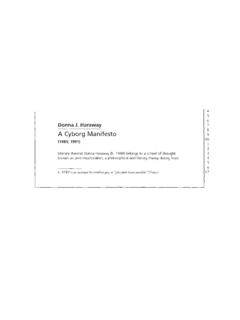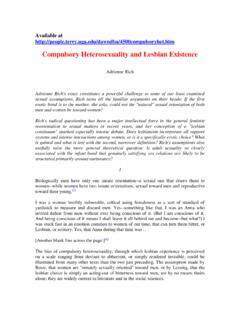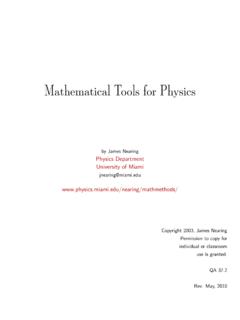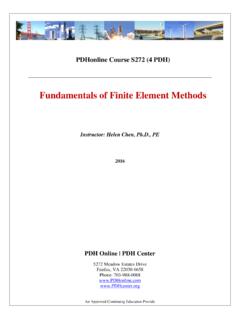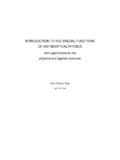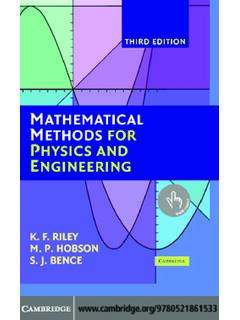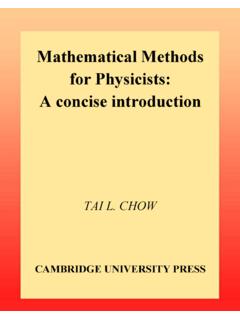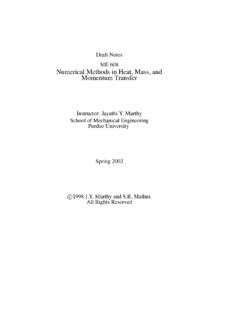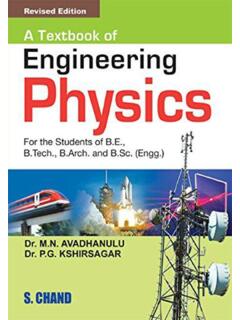Transcription of Mathematical methods of classical mechanics-Arnold V.I.
1 Arnold Mathematical methods of classical mechanics Second Edition Translated by K. Vogtmann and A. Weinstein With 269 Illustrations Springer-Verlag New York Berlin Heidelberg London Paris Tokyo Hong Kong Barcelona Budapest V. I. Arnold K. Vogtmann A. Weinstein Department of Department of Department of Mathematics Mathematics Mathematics Steklov Mathematical Cornell University University of California Institute Ithaca, NY 14853 at Berkeley Russian Academy of Berkeley, CA 94720. Sciences Moscow 117966. GSP-1. Russia Editorial Board J. H. Ewing F. W. Gehring Halmos Department of Department of Department of Mathematics Mathematics Mathematics Indiana University University of Michigan Santa Clara University Bloomington, IN 47405 Ann Arbor, MI 48109 Santa Clara, CA 95053. Mathematics Subject Classifications (1991): 70 HXX, 70005, 58-XX.
2 Library of Congress Cataloging-in-Publication Data Amol 'd, (Vladimir Igorevich), 1937- [Matematicheskie melody klassicheskoi mekhaniki. English]. Mathematical methods of classical mechanics I Amol 'd;. translated by K. Vogtmann and A. ed. p. (Graduate texts in mathematics ; 60). Translation of: Mathematicheskie metody klassicheskoi mekhaniki. Bibliography: p. Includes index. ISBN 0-387-96890-3. I. mechanics , Analytic. I. Title. II. Series. 1989. 531 '.01 '515-dcl9 88-39823. Title of the Russian Original Edition: M atematicheskie metody klassicheskoi mekhaniki. Nauka, Moscow, 1974. Printed on acid-free paper 1978, 1989 by Springer-Verlag New York Inc. All rights reserved. This work may not be translated or copied in whole or in part without the written permission of the publisher (Springer-Verlag, 175 Fifth Avenue, New York, NY 10010, ), except for brief excerpts in connection with reviews or scholarly analysis.
3 Use in connec- tion with any form of information storage and retrieva~ electronic adaptation, computer software, or by similar or dissimilar methodology now known or hereafter developed is forbidden. Printed and bound by R. R. Donnelley and Sons, Harrisonburg, Virginia. Printed in the United States of America. 9 8 7 6 5 4 3 (Third corrected printing.). ISBN 0-387-96890-3 Springer-Verlag New York Berlin Heidelberg ISBN 3-540-96890-3 Springer-Verlag Berlin Heidelberg New York Preface Many different Mathematical methods and concepts are used in classical mechanics : differential equations and phase flows, smooth mappings and manifolds, Lie groups and Lie algebras, symplectic geometry and ergodic theory. Many modern Mathematical theories arose from problems in mechanics and only later acquired that axiomatic-abstract form which makes them so hard to study.
4 In this book we construct the Mathematical apparatus of classical mechanics from the very beginning; thus, the reader is not assumed to have any previous knowledge beyond standard courses in analysis (differential and integral calculus, differential equations), geometry (vector spaces, vectors) and linear algebra (linear operators, quadratic forms). With the help of this apparatus, we examine all the basic problems in dynamics, including the theory of oscillations, the theory of rigid body motion, and the hamiltonian formalism. The author has tried to show the geometric, qualitative aspect of phenomena. In this respect the book is closer to courses in theoretical mechanics for theoretical physicists than to traditional courses in theoretical mechanics as taught by mathematicians. A considerable part of the book is devoted to variational principles and analytical dynamics.
5 Characterizing analytical dynamics in his "Lectures on the development of mathematics in the nineteenth century," F. Klein wrote that " .. a physicist, for his problems, can extract from these theories only very little, and an engineer nothing." The development of the sciences in the following years decisively disproved this remark. Hamiltonian formalism lay at the basis of quantum mechanics and has become one of the most often used tools in the Mathematical arsenal of physics . After the significance of symplectic structures and Huygens' principle for all sorts of optimization problems was realized, Hamilton's equations began to be used constantly in v Preface engineering calculations. On the other hand, the contemporary development of celestial mechanics , connected with the requirements of space exploration, created new interest in the methods and problems of analytical dynamics.
6 The connections between classical mechanics and other areas of mathe- matics and physics are many and varied. The appendices to this book are devoted to a few of these connections. The apparatus of classical mechanics is applied to: the foundations of riemannian geometry, the dynamics of an ideal fluid, Kolmogorov's theory of perturbations of conditionally periodic motion, short-wave asymptotics for equations of Mathematical physics , and the classification of caustics in geometrical optics. These appendices are intended for the interested reader and are not part of the required general course. Some of them could constitute the basis of special courses (for example, on asymptotic methods in the theory of non- linear oscillations or on quasi- classical asymptotics). The appendices also contain some information of a reference nature (for example, a list of normal forms of quadratic hamiltonians).
7 While in the basic chapters of the book the author has tried to develop all the proofs as explicitly as possible, avoiding references to other sources, the appendices consist on the whole of summaries of results, the proofs of which are to be found in the cited literature. The basis for the book was a year-and-a-half-long required course in classical mechanics , taught by the author to third- and fourth-year mathematics students at the mathematics- mechanics faculty of Moscow State University in 1966-1968. The author is grateful to I. G. Petrovsky, who insisted that these lectures be delivered, written up, and published. In preparing these lectures for publication, the author found very helpful the lecture notes of L. A. Buni- movich, L. D. Vaingortin, V. L. Novikov, and especially, the mimeographed edition (Moscow State University, 1968) organized by N.
8 N. Kolesnikov. The author thanks them, and also all the students and colleagues who communi- cated their remarks on the mimeographed text; many of these remarks were used in the preparation of the present edition. The author is grateful to Leontovich, for suggesting the treatment of connections by means of a limit process, and also to I. I. Vorovich and V. I. Yudovich for their detailed review of the manuscript. V. ARNOLD. The translators would like to thank Dr. R. Barrar for his help in reading the proofs. We would also like to thank many readers, especially Ted Courant, for spotting errors in the first two printings. Berkeley, 1981 K. VOGTMANN. A. WEINSTEIN. VI. Preface to the second edition The main part of this book was written twenty years ago. The ideas and methods of symplectic geometry, developed in this book, have now found many applications in Mathematical physics and in other domains of applied mathematics, as well as in pure mathematics itself.
9 Especially, the short-wave asymptotical expansions theory has reached a very sophisticated level, with many important applications to optics, wave theory, acoustics, spectroscopy, and even chemistry; this development was parallel to the development of the theories of Lagrange and Legendre singularities, that is, of singularities of caustics and of wave fronts, of their topology and their perestroikas (in Russian metamorphoses were always called "perestroikas," as in "Morse perestroika" for the English "Morse surgery"; now that the word perestroika has become international, we may preserve the Russian term in translation and are not obliged to substitute "metamorphoses" for "perestroikas" when speaking of wave fronts, caustics, and so on). Integrable hamiltonian systems have been discovered unexpectedly in many classical problems of Mathematical physics , and their study has led to new results in both physics and mathematics, for instance, in algebraic geometry.
10 Symplectic topology has become one of the most promising and active branches of "global analysis." An important generalization of the Poincare "geometric theorem" (see Appendix 9) was proved by C. Conley and E. Zehnder in 1983. A sequence of works (by M. Chaperon, A. Weinstein, Sikorav, M. Gromov, Ja. M. Eliashberg, Ju. Tchekanov, A. Floer, C. Viterbo, H. Hofer, and others) marks important progress in this very living domain. One may hope that this progress will lead to the proof of many known conjectures in symplectic and contact topology, and to the discovery of new results in this new domain of mathematics, emerging from the problems of mechanics and optics. Vll Preface to the second edition The present edition includes three new appendices. They represent the modern development of the theory of ray systems (the theory of singularity and of perestroikas of caustics and of wave fronts, related to the theory of Coxeter reflection groups), the theory of integrable systems (the geometric theory of elliptic coordinates, adapted to the infinite-dimensional Hilbert space generalization), and the theory of Poisson structures (which is a general- ization of the theory of symplectic structures, including degenerate Poisson brackets).

